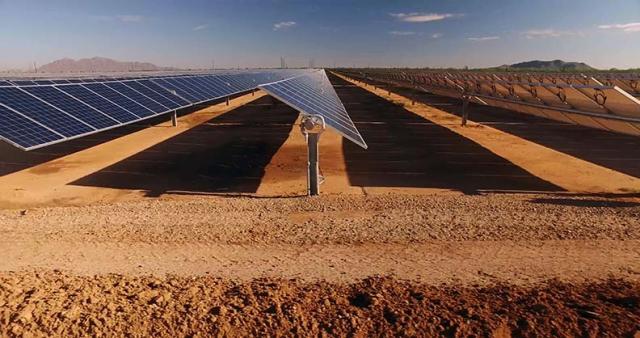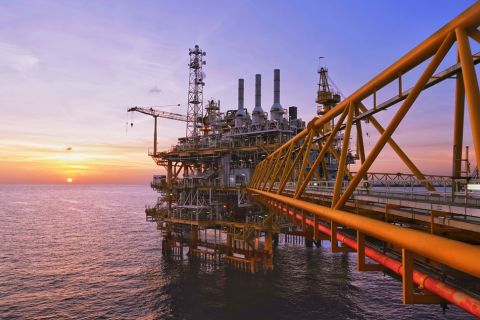
Even as Saudi Arabia slides from its position as the world capital of oil of gas, its energy tradition remains strong.
When you think of Saudi Arabia you think of a nation that is oil and gas rich and its current energy mix—51% oil and 49% gas—does nothing to dispel that reputation. But Paddy Padmanathan, the CEO and president of Saudi Arabia-based ACWA Power International, envisions a day soon when renewable energy sources will dominate the mix of the Middle East.
Before that day comes, in the next 12 years, he says, gas and renewables will have to work in tandem as oil fades from Saudi Arabia’s energy mix.
“I’m already there that gas is the transition fuel, my only question is how long will gas be needed,” Padmanathan said while speaking on a three-member panel about natural gas and renewable as perfect partners during CERAWeek by IHS Markit in early March. “Renewables will continue to penetrate and I think renewable will start penetrating faster.
“Gas and renewables today are very supportive of each other and will be for some time to come, but ultimately we will head towards a world of pretty much 100% renewable.”
VIDEO: HART ENERGY CONNECT: Power Company CEO Says Natural Gas, Renewables Make Great Companions: Paddy Padmanathan believes renewables will pack a competitive punch to the oil and gas markets, but says that will take time.
Padmanathan doesn’t see that day coming, however, until a 24-hour battery can be developed that will drive down renewable costs to the point that natural gas and oil can’t compete. Until then, natural gas and renewables will complement each other.
Ernie Thrasher, who is the CEO and Chief Marketing Officer for Xcoal & XLNG Energy and Resources, believes coal can also continue to be part of the energy miss despite many of the emissions concerns about the carbon-burning source.
“I’m certainly a proponent of improved use of gas. I think that a natural transition in energy space as energy grows,” Thrasher said. “But again I think coal is also a part of that.
“As we’ve seen in Germany it can also be a partner with renewables. I think emissions, other than carbon, coal can be very compliant. It’s the carbon issue that has to be solved, but it has to be solved for gas also.”
What’s interesting is, as energy demand continues to grow around the world, there has been a welcoming of renewable energy in oil-rich Middle East nation’s like Saudi Arabia. Padmanathan said part of the push is emissions but he also admits that the day is coming where the use of renewable energy sources will be cheaper than pulling oil and gas from the ground where the sources are plentiful and economical.
That may hard to imagine in a nation where currently renewable energy accounts for zero percent of the energy mix. But renewable energy will represent a significant cost savings to customers in the Middle East where the sun shines 7.5 to 8 hours a day during the winter and even longer during the summer months.
“Within the next 12 years, even as we continue even as we continue to grow demand the mix will change to just under 50% of renewables from zero today,” Padmanathan said. “So that is 60 megawatts of renewable in Saudi Arabia.
“Just about every country is pursuing significant renewable volumes. They start off slow. They buy 500, 200, 100 and they jump straight to 1,000 from a 500 megawatt project. Why? Because they see the prices on the renewable side. In Dubai, we just started construction of a 1,000-megawatt project. It’s taking the heat of the sun and storing the heat so that we can use it at night turning the turbines.”
Padmanathan said customers in the Middle East are asking for a particular mix, and the nation is responding to it.
The potential for savings can be seen even now, even in a place where the expense of pulling gas out of the ground remains relatively low. That is why nation’s like Morocco and the United Arab Emirates are forging ahead by investing in renewable energy. Morocco has a 510 megawatt plant in place and the UAE is in the process of building a 951 megawatt facility.
Padmanathan said over the next 35 years, those plants will be distributing electricity at 7.3 cents per kilowatt hour fixed during the day and night with solar energy. Currently, the UAE doesn’t produce any gas but purchases gas from Qatar on the spot LNG market at 7.8 cents a kilowatt hour.
“Already what you are starting to see is renewable energy eating into that gas base load space,” he said. “What we will see going forward is more and more of that. I am convinced that 7.3 cents will come down. I’m convinced that a project at a different location today with a slightly better resource can deliver at 6.5 cents per kilowatt hour.”
According to Padmanathan, his company is deploying $7 billion to $8 billion in capacity in new investments each year to its portfolio and more than 60% of that is going towards renewable energy.
“We see it for a very good reason because. Every part of the world has a different problem,” Padmanathan said. “The part that we are serving, demand is growing so there is additional capacity so the choices that are being made are about how do we serve that additional capacity?
“There the choices are very simple, take advantage of today’s offering. The other thing is some of the countries like Saudi Arabia, Morocco who have started to absorb a significant part of the renewables also recognize that renewable energies is very different as opposed to conventional in terms of what goes into building the plant. We can localize content much faster or easier. So not only can they end up getting the energy at a cheaper price but they can also start to boost their economy by bringing local.”
So where does this leave coal?
From Thrasher’s perspective, coal should remain very much a part of the energy mix despite numbers that indicate the use of coal is declining. Thrasher said coal is likely to be 30% of the energy mix until 2035.
“The amount of coal being consumed in the world is growing despite the popular belief that coal consumption is declining,” he said. “The growth is declining but the amount of coal that is being produced is growing.”
“I certainly think it will continue for the next 5 to 10 years, certainly in Southeast Asia.”
Thrasher cautions those who rely on the belief that a carbon tax will eventually prohibit coal from being competitive with renewable energy and LNG.
“Three different people can look at something and come up with three different analysis of costs at the end of the day,” Thrasher said. “In India for example, coal in a 10 BTU facility in India coal in that market costs 3.5 cents but you have power plants in India that are running at 50% to 70% so the incremental cost of running that plant at 90% is just slightly over 3.5 or 4 cents and in place like energy where the cost of energy to large section of society is very critical, coal will play a role in the fuel mix.”
Recommended Reading
TotalEnergies Starts Production at Akpo West Offshore Nigeria
2024-02-07 - Subsea tieback expected to add 14,000 bbl/d of condensate by mid-year, and up to 4 MMcm/d of gas by 2028.
E&P Highlights: Feb. 5, 2024
2024-02-05 - Here’s a roundup of the latest E&P headlines, including an update on Enauta’s Atlanta Phase 1 project.
CNOOC’s Suizhong 36-1/Luda 5-2 Starts Production Offshore China
2024-02-05 - CNOOC plans 118 development wells in the shallow water project in the Bohai Sea — the largest secondary development and adjustment project offshore China.
US Drillers Cut Oil, Gas Rigs for First Time in Three Weeks
2024-02-02 - Baker Hughes said U.S. oil rigs held steady at 499 this week, while gas rigs fell by two to 117.
Equinor Receives Significant Discovery License from C-NLOPB
2024-02-02 - C-NLOPB estimates recoverable reserves from Equinor’s Cambriol discovery at 340 MMbbl.




